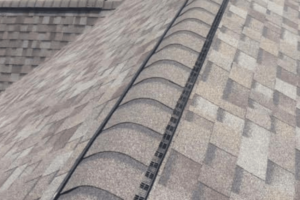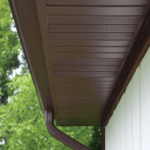How to Improve Roof Ventilation to Prolong Your Home’s Roof
As a homeowner, you want to protect your home and everything inside it. A great place to start is to protect and maintain the health of your roof. When damage happens to the exterior of your home and especially your roof, it can have major repercussions that affect your home and your family. Our Des Moines roofing company wants to help homeowners prolong the health of their roof, and the best way to do that is by following proper roof ventilation practices.
What is Roofing Ventilation?
Roof ventilation is a system of intake and exhaust vents that provide air circulation to keep the atmosphere inside a home comfortable. Without the in and out passages involved in roof ventilation, hot air will get trapped within your home, causing a variety of problems for your property.
So what’s the best way to improve roof ventilation? The climate you live in and other property factors should be taken into consideration when determining which type of roof vents will provide the most useful functionality.
2 Types of Roofing Ventilation Options
- Natural Ventilation – Hot air rises within a home and creates pressure in the attic. If this high-pressure air is given an outlet to escape, it will automatically be replaced by cool, low-pressure air. By installing various types of roof vents, homeowners can take advantage of natural air flow to provide proper roof ventilation and keep the inside of the home comfortable. Natural ventilation can also be achieved through doors, windows and other gaps.
- Mechanical Ventilation – For some structures, it may be necessary to use a system of mechanical vents. This type of roofing ventilation requires a power source to provide constant air flow. Mechanical roofing ventilation options are necessary if the design of the roof doesn’t allow much air flow or the home is in an area without much wind.
Why Is It Important to Have Proper Roofing Ventilation?
Improving your roof ventilation will help keep your roof and the rest of your home in prime condition. If you’re not following proper roofing ventilation tips, warm air will become trapped in your home and cause issues that can lead to costly repairs, which we’ll cover in the signs of poor roof ventilation section.
Maintaining your home’s roofing ventilation is especially important in the Midwest because we experience both extremely cold and hot weather. Roofing ventilation options should protect your home from each of these scenarios:
- Hot air trapped in your home during the summer, making it difficult to keep your home cool
- Trapped hot air causing issues like mold, mildew or ice dams in the winter
Signs of Poor Roof Ventilation
Icicles & Ice Dams – When there’s snow piled up on the roof and you start to notice large ice dams forming along the roof, that means there’s a problem with the roof ventilation. Ice dams form when the roof is heating up, the snow is melting and then the running water is freezing once it reaches the edge of the roof. This is a major indicator of poor roof ventilation and can cause more serious issues. Learn more in our blog about how to avoid ice dams.
Your Air Conditioner Breaks Down – Many people don’t correlate the condition of their A/C with the health of their roof, but if you don’t have the proper roof ventilation in place, you could be overworking your air conditioner. On hot summer days when all the hot air is trapped indoors, your A/C is working in overdrive to keep the house cool. This puts stress on your HVAC system, and can shorten the lifespan of the unit. If your A/C has broken down more than once, there’s a good chance you have ventilation problems.
Hot or Cold Areas in The Home – Have you ever felt a noticeable increase in temperature when you walk up the stairs or from room to room? This is another sign of poor roof ventilation. Extremely hot or cold areas in the home is another sign that your heating, cooling and ventilation systems are not keeping up with the demand.
Roof Leaks, Mold & Mildew If homeowners ignore the warning signs of poor roof ventilation, it can lead to serious problems later on for your home and your health. When your roof is exposed to water damage over time, or suffered major destruction from a bad storm, this can cause roof leaks. If these are not treated right away, the excess water in the home could create additional problems like mold, mildew and more.
Unwanted Pests Found Inside – Some roof ventilation issues lead to damage to the exterior of your home. If your roof, gutters or siding have been damaged in the past, it could allow critters to find a way inside. Whether you have tiny insects that can creep in through tiny cracks and crevices, or squirrels and rodents that can scratch their way indoors, any of these unwanted pests could be an indicator that there’s an issue with your roof.
How to Improve Roofing Ventilation
If you’re noticing any of the signs of poor roof ventilation above, it’s time to make some changes to improve the roof ventilation in your home. Roof vent installation is an easy task for roofers when replacing a roof since many roofing ventilation options can be installed under the shingles of the roof or mounted outside the roof. There are many different types of roof vents, so we’ll discuss your roofing ventilation options in more detail below.
2 Types of Roofing Ventilation Systems
Exhaust Vents: Allow Hot Air to Escape The Home

Ridge Vents
Ridge vents are installed at a roof intersection, typically at the top of the roof, under shingles. This makes the ridge roof vent installation an easy addition to the roofing process.

Wind Turbines
Wind turbines are attached on the outside of the roof. This type of roof vent is designed to catch wind and air flow in its turbines and cycle the hot air out of the home as it replaces it with cooler wind.

Box Vents
Box vents serve the same purpose as the other types of roofing ventilation systems, but you’ll need more of these vents on your roof, and they will be more noticeable than other roofing ventilation options.

Power Attic Ventilators
Power attic ventilators are a mechanical roof ventilation option for homes that do not get a lot of natural wind exposure. This electric roof vent will run continuously to ensure the home is getting the proper roof ventilation it needs.
Intake Vents: Allow Cool Air to Enter The Attic
Along with exhaust vents that release the hot air in the attic, it is beneficial to have intake vents to strengthen the air flow process. Edge vents can be installed under soffits or under shingles near the drip edge by gutters. Intake vents are essential for cycling cool air through the home to prevent overheating.
Benefits of Proper Roof Ventilation
Save Energy Costs – Poor ventilation can lead to rising temperatures in the attic, which spill over to the rest of the home. This leads to high electricity bills, inconsistent heating and cooling within the home and puts more burden on your HVAC units.
Keep Your Home Healthier & More Comfortable – Improper roof ventilation can lead to mold and mildew build up, which can not only damage your roof but pose health risks to your family. Additionally, you won’t have to deal with temperature changes within the home when you follow proper roof ventilation tips.
Prolong The Life of Your Roof – Poor roof ventilation can cause damage and lead to a shorter lifespan for your roof. The top damages include:
- Shingles get very hot and prematurely age when poor roof ventilation keeps the attic too warm.
- Ice dams are a sign of poor roof ventilation, and they cause damage to shingles and eaves. If left untreated, they can even cause roof leaks.
- Moisture buildup from various roof ventilation problems can lead to swelling and rot, which can result in nails not holding and reduced roof capacity
Schedule a Free Property Evaluation
The team at Superstorm Restoration is passionate about helping homeowners get the most value out of their roof. Make sure you’re following proper roof ventilation tips by getting a drone roof inspection or by scheduling a roof vent installation.
Our experts will assist you in choosing the best type of roofing ventilation system for your home. Browse our roofing service options to take the next step in extending the life of your roof, contact our team or book your appointment with Superstorm Restoration today.
Recent Posts
- Understanding Gutter Types and Sizes
- Giving Back To Our Community
- Prepare Your Home And Business For Severe Wind Storms Like A Derecho
- Comprehensive Guide to Roof Financing for Property Owners
- Understanding Your Insurance Claim After a Storm
- Protect Your Roof To Protect Your Home – Roof Maintenance Checklist for Every Season
- Deciphering Good vs. Bad Roofing Jobs
- Expert Tips for Property Owners On How to Choose the Right Contractor After a Storm
- How Much Does a New Roof Cost in 2024?
- Iowa Severe Weather Awareness Week 2024

